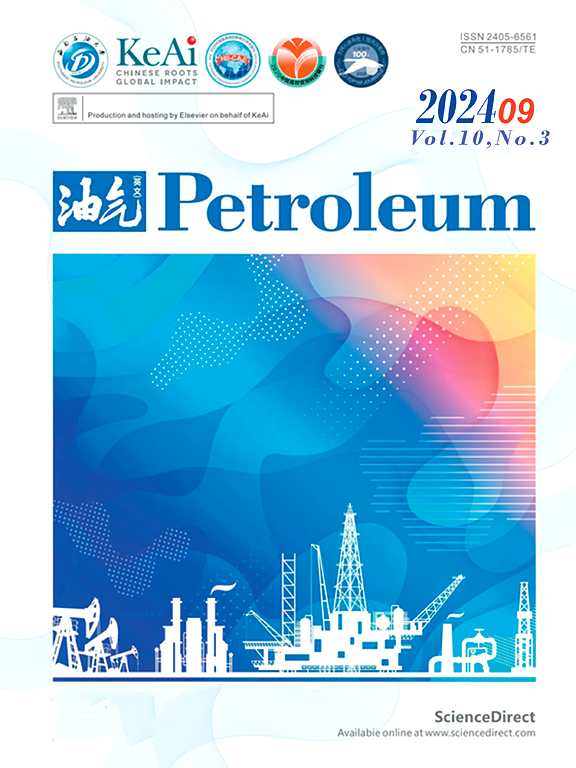Discussion of the feasibility of spontaneous ignition, oil requirement, and air requirement for air injection in shale and tight reservoirs
IF 4.2
Q2 ENERGY & FUELS
引用次数: 0
Abstract
Because of the nature of low permeability of shale and tight reservoirs, a gas injection method has the advantage of enhancing oil recovery. Among gases, air has its vast and free resources. And one extra benefit is its thermal effect resulting from combustion. However, issues of feasibility of spontaneous ignition, oil requirement, and air requirement for the continuation of combustion in shale and tight reservoirs need to be addressed. This paper is to address these issues with the aid of numerical simulation. The relevant literature information is reviewed when discussing these issues. It is found that failure of spontaneous ignition may be caused by more factors such as vaporization, fuel displacement by air, etc., in addition to lack of oil exothermicity and heat loss that are commonly believed; the oil saturation difference between the initial oil saturation and the remaining oil saturation after air flooding and low-temperature oxidation is proposed to define the oil content; air requirement may not be satisfied in typical shale or tight reservoirs because of the low injectivity. More factors can complicate the issues of feasibility of spontaneous ignition, oil requirement, and air requirement. Therefore, a simulation approach is more appropriate to address those issues.
探讨了页岩和致密储层注气自燃的可行性、注油需求和注气需求
由于页岩和致密储层的低渗透特性,采用注气方法具有提高采收率的优势。在气体中,空气有其丰富的免费资源。一个额外的好处是它的燃烧产生的热效应。然而,在页岩和致密储层中,自燃的可行性、油需求和持续燃烧的空气需求等问题都需要解决。本文将借助数值模拟来解决这些问题。在讨论这些问题时,回顾了相关的文献资料。发现自燃失败除了缺乏普遍认为的油放热性和热损失外,还可能有汽化、燃料被空气置换等更多因素引起;提出了气驱和低温氧化后初始油饱和度与剩余油饱和度之差来确定含油量;在典型的页岩或致密储层中,由于注入能力低,可能无法满足对空气的要求。更多的因素会使自燃可行性、油需求和空气需求等问题复杂化。因此,模拟方法更适合解决这些问题。
本文章由计算机程序翻译,如有差异,请以英文原文为准。
求助全文
约1分钟内获得全文
求助全文
来源期刊

Petroleum
Earth and Planetary Sciences-Geology
CiteScore
9.20
自引率
0.00%
发文量
76
审稿时长
124 days
期刊介绍:
Examples of appropriate topical areas that will be considered include the following: 1.comprehensive research on oil and gas reservoir (reservoir geology): -geological basis of oil and gas reservoirs -reservoir geochemistry -reservoir formation mechanism -reservoir identification methods and techniques 2.kinetics of oil and gas basins and analyses of potential oil and gas resources: -fine description factors of hydrocarbon accumulation -mechanism analysis on recovery and dynamic accumulation process -relationship between accumulation factors and the accumulation process -analysis of oil and gas potential resource 3.theories and methods for complex reservoir geophysical prospecting: -geophysical basis of deep geologic structures and background of hydrocarbon occurrence -geophysical prediction of deep and complex reservoirs -physical test analyses and numerical simulations of reservoir rocks -anisotropic medium seismic imaging theory and new technology for multiwave seismic exploration -o theories and methods for reservoir fluid geophysical identification and prediction 4.theories, methods, technology, and design for complex reservoir development: -reservoir percolation theory and application technology -field development theories and methods -theory and technology for enhancing recovery efficiency 5.working liquid for oil and gas wells and reservoir protection technology: -working chemicals and mechanics for oil and gas wells -reservoir protection technology 6.new techniques and technologies for oil and gas drilling and production: -under-balanced drilling/gas drilling -special-track well drilling -cementing and completion of oil and gas wells -engineering safety applications for oil and gas wells -new technology of fracture acidizing
 求助内容:
求助内容: 应助结果提醒方式:
应助结果提醒方式:


